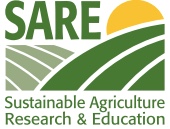Sustainable Agriculture Research and Education (SARE)
"Harnessing Microbes for Sustainable Food Production"
Education Materials
The articles and summaries in this section provide insight to the following key topics that are relevant to the SARE project: Agricultural Practices and Water Quality, Agroecosystem Concepts, Anaerobic Digestion by Microbes, Beneficial Soil Microbes, Compost Microbes, Plant Disease & Soil Disinfection, & Disease Suppression by Soil Amendment, Soil Amendment Biosolids Safety, Soil Health Concept & Indicators, Soil Management Practices, Sustainable Agriculture Practice & Microbes, and Sustainable Waste Management
-
Agricultural Practices & Water Quality
Agriculture is one of the top consumers of water in the world. Water, unlike other resources, is renewable so long as the resource is not overused to the point of depletion. This means that when water is used in any setting, it continues to flow through the water cycle to other aspects of the ecosystem.
Water that is applied to farm lands can evaporate into the atmosphere or flow into watersheds or aquifers through soils. Excess amount of nutrients that are placed on farmlands through the use of fertilizer can leach from soil to watersheds, which may add nutrients into aquatic waterbodies such as lakes, wetlands, streams and aquifers.
Eutrophication is the term for excessive productivity and algae growth in water due to an influx of nutrients. Eutrophication, harmful algae blooms, and nitrate issues in springs and aquifers are all the result of nutrient pollution.
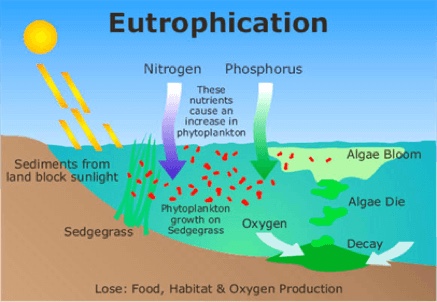
An example of eutrophication and the resulting algae growth, from: https://onlinesciencenotes.com/eutrophication-causes-effects-and-controlling-measures/
-
Agricultural Practices & Water Quality Part 2
Nutrients that are released from farmlands are referred to as one type of non-point source pollution. Eutrophication, mentioned previously, is a common example of non-point source pollution. Non-point source pollution is a great example of how communities must work together to ensure the good health and upkeep of their watershed.
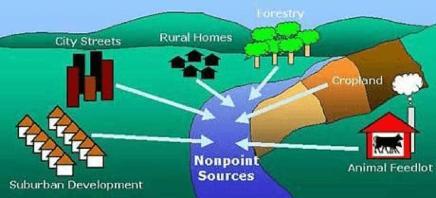
The nature of water makes it especially good at carrying nutrients and other pollutants after they have been dissolved, so the best way to manage harmful impacts on watersheds is to demonstrate proper foresight when dealing with nutrients and chemicals that may be washed away or have direct contact with a shared water source. Expect water to travel through the environment carrying any contaminants gathered along the way until they reach to adjacent waterbodies. Pesticides and herbicides entering the water have detrimental effects on the wildlife they come into contact with!
Agricultural practices that help maintain water quality include:
- Do not excessively till the land. This loosens the soil and makes it more likely to wash away, while also giving the water more access to the nutrients below the outer layer for leeching.
- Account for all nutrients present in the soil. Keep record of the nutrients applied, amount remaining in the soil, and those lost to plant growth. These levels should not exceed the amount necessary for the crop being grown, as this may lead to movement of nutrients (leaching).
- Vary pest management practices. By keeping the pest management practices varied (ex. crop rotation, intercropping), pesticides may only become necessary in dire situations while also minimizing pollution.
- Implement conservation buffers. Placing a buffer plant (such as thick grass) at the edge of an agricultural area can capture some pollutants before they are able to runoff into the waterways.
(for more suggestions, please visit https://cfpub.epa.gov/watertrain/moduleFrame.cfm?parent_object_id=1362)
-
Agroecosystem Concept
It is easy to imagine a divide between agricultural land and a natural ecosystem. Especially in instances where cash crops are not native, monoculture is practiced, or the soil is constantly being altered, it is easy to lose sight of the true relationship between farmland and the natural ecosystem. Adoption of agroecosystem concepts allows us to see farms as a part of natural ecosystems. While cultivating lands for food production, farms can also help increase and maintain wildlife diversity. By taking advantage of natural resources (such as predators), farmers could control pests and create a healthier environment for increased yield.
Due to the relationship between farmland and the surrounding wildlife, farms are truly part of a regional ecosystem and actively impact the environment surrounding them. The key principles of agroecology are:
- Enhancing species and genetic diversification of the agro-ecosystem
- Enhancing beneficial biological interactions and synergies among components of agro-biodiversity and the surroundings, thus promoting key ecological processes and functions.
(Taken from https://www.oxfamamerica.org/static/media/files/ib-building-new-agricultural-future-agroecology-280414-en.pdf)
Agroecology favors the incorporation of more genetic diversity and improving biological interactions between surroundings. These points have notable overlap, as polyculture has been shown to reduce pest populations and slow the spread of disease, while genetic diversity is further enabled by the presence of unrelated and diverse wildlife outside of the farm. Genetic diversity is also crucial in crops themselves, since a variety of different plants will be more resistant to disease and infestation than a monoculture, thus providing greater security and ensuring plants remain healthy.
-
Plant Disease & Soil Disinfection & Disease Suppression by Soil Amendment
The realm of the rhizosphere is flush with a diverse array of microorganisms. Plant disease can be suppressed by an overwhelming population of other microbes, specifically ones that act antagonistically. There is a difference between suppression of a disease and eradication of disease. In most cases, disease severity is not extreme enough to call for eradication methods like soil solarization and fumigation. These practices of eradication are extremely effective in elimination of undesirable organisms like predatory nematodes, insects of economic concern and plant pathogens, but act indiscriminately and eliminate beneficial soil dwelling organisms as well. When a soil is “wiped clean” with such a practice, it becomes free real estate for any organism, beneficial or pathogenic alike.
Compost has been shown to be able to suppress disease incidence, but it’s not quite that simple. Suppression of pathogens is not guaranteed, and the presence of certain microbes are responsible for the suppressive effect. Some organisms, like Trichoderma species have been found to be mycoparasites of Sclerotium rolfsii, an economically significant fungal plant pathogen. Antagonistic microorganisms can be found in mature composts, and they tend to repopulate the edges of compost piles that do not experience a high rise in temperature. Overmatured composts tend to have lower capacity for disease suppression likely related to the loss of biological activity. The use of conservation practices like green manure, organic amendments, crop rotation, and minimal tillage practice are also effective at increasing soil biodiversity which can contribute to disease suppression.
There are five identified mechanisms of disease suppression. Each mechanism may bring the same result, pathogen suppression, but differ in the way that causes the suppression. Competition is related to essential food for microbes, carbon and nutrient sources. Antibiotics may be produced which are toxic to other microorganisms. Pathogens may be consumed by predatory microbes or may be parasitized. Disease resistant genes related to a plant’s induced resistance may be activated by microorganisms in compost. And lastly, certain microbes may improve plant nutrition which leads to enhanced plant disease resistance. The first three mechanisms (competition, antibiosis, and predation) interact directly with pathogenic organism and the final two mechanisms interact indirectly with the pathogen.
More research on this subject is required to determine exactly what organisms are responsible for suppressing specific diseases. An understanding of the complex relationships that exist within soil is possible with additional research on soil meta genomics.
Compost Disease Suppression PDF
-
Sustainable Farm Waste Management
When farming, wastes are inevitably generated alongside the desired product. Whether these are crop residues, rotten produce, or animal feces, the waste must be carefully disposed of or contained to avoid pollution or contamination of nearby areas. Some waste can even be utilized and recycled to provide additional nutrients or energy for farm operations.
1. Composting
One way we can utilize or recycle such waste is by composting. Compost provides a stable and nutrient rich organic matter to the soil, formed from the decomposition of organic waste material under controlled conditions. The decomposition of organic waste materials is carried out by microbial consortia that are present within compost piles. The oxygen level, pH, moisture content, temperature, and organic nitrogen content are all known to affect such microbial-dependent degradation processes. Microbial compositions that play roles in waste degradation processes change over time as compost chemistry and environments change. Microbes that are involved in these organic degradation processes are mainly aerobes which include thermo-tolerant bacteria, filamentous bacteria (actinomycetes), and saprotrophic fungi. While amending soil with compost is incredibly beneficial to plants, it is worth noting that the long-term effects on soil structure, microbiome, and chemistry provide even greater long-term benefits.
2. Anaerobic digestion (Biogas)
Another way to utilize such organic waste generated within farms is anaerobic digestion. Digesting the “wet” organic wastes such as manure and other organic wastes in anaerobic conditions with the help of microorganisms generates methane gas. This digestion of organic matter is substantially slower than degradation that occurs during composting. This is partly because the digestion occurs in anaerobic conditions (free of oxygen). The microbes involved in this process are anaerobes including microbes that degrade large polymers, microbes that break organic molecules into smaller fatty acids, and microbes that synergistically work with methanogens, which eventually convert small volatile fatty acids into methane. This biogas can be utilized for heat and energy, while the remaining materials include nutrient-rich wastewater (digestates) that can be used as an organic fertilizer.
-
Beneficial Soil Microbes
Interactions that occur in soil are complex, involving physical, chemical and biological processes. These interactions within soil are intangible and not always obvious just from looking at it. The different types of interactions that occur within soil can help to enhance the ability for soil to grow crops. Some of these interactions include those formed between plant roots and beneficial soil microbes, such as mycorrhizal fungi (Figure 1) and rhizobia bacteria (Figure 2). Soil microbes form symbiotic relationships with plant roots to help the soil with a variety of different functions, including water retention, nutrient mineralization, decomposing organic matter, disease suppression and many other benefits that improve crop land.
Mycorrhizal fungi forms structures in the rhizosphere, which is the region around plant roots in the soil, called hyphae that extend out from the roots and enhance nutrient and water uptake for the plant (Figure 1). Plants benefit from mycorrhizal fungi because the fungi can supply the plant with phosphate, and the fungi receives carbon from the plant, completing their symbiotic relationship (Abiala et al., 2013). Some studies also suggest that mycorrhizal fungi also enhances the number of nitrogen fixing bacteria that are present in the soil. These mycorrhizal activities are beneficial to plants because less synthetic nutrients would need to be added to the soil if they are provided through biological processes. Utilizing the microbial community as biofertilizer can be a much more sustainable method of food production (Igiehon & Babalola, 2017). In order to protect the community of mycorrhizal fungi, there are certain management practices that would be better to forgo. Some such practices that can be harmful to mycorrhizal fungi include tillage, erosion, bare soils, and pesticides. The addition of synthetic nutrients also bypass mycorrhizal activities, thus they are not enriched in the soil. Avoiding or reducing these practices would be a very effective way to protect these beneficial soil microbes in order to continue reaping the benefits they provide.
Rhizobia bacteria, that colonizes bulb shaped nodules of legume plants, is another very important soil microbe and can fix nitrogen in the nodules (Figure 2). The rhizobia bacteria infect the hairs on the legume root and are able to turn into nitrogen fixing bacteroids (Harman & Uphoff, 2019). This process can not only provide nitrogen for host legume plants, but also benefit future crops as well because any excess nitrogen would be released into the soil. This nitrogen could then be utilized by crops in the future. Protecting and enhancing beneficial soil microbes is a great way to utilize what is typically already present in the soil, and can greatly enhance farming practices.
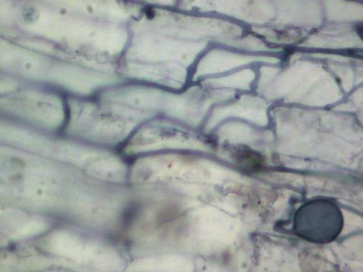
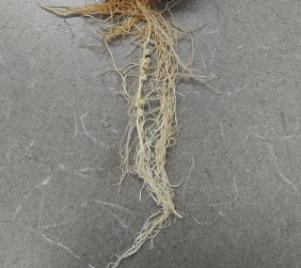
Fig. 1 Fig. 2a: Nodules of legume plant

Fig. 2b: Rhizobium within a nodule visualized using a light (optical) microscope.
For more information, please visit the following links or articles.
FAO website
Farm Progress
https://www.farmprogress.com/soil-health/heres-how-grow-more-mycorrhizal-fungi
Fungi Perfecti
- Soil Amendment
- Soil Health Concept and Indicators
-
Soil Management Practices
Farming, both large and small scale, depends heavily on the quality of soil the plants are raised in. The plants may receive additional nutrients from fertilizers, but for proper health and wellbeing of the crop it is essential that the soil is able to retain both nutrients and water properly (Schmidt et al., 2011). As soil itself contains an ecosystem that cycles nutrients between natural decomposing matter, plants, and the microbiome, it is crucial that the balance is maintained to ensure proper soil structure. Farming naturally disrupts soil processes through tilling and crop removal, which accelerates the decomposition of organic matter and breaks soil aggregates. Improper soil management practices create a weakened soil more susceptible to erosion and likely to pose an issue regarding nutrient availability and water retention.
There are two main methods for improving soil structure: increasing soil organic matter and increasing the microbial biomass.
Increasing soil organic matter can be accomplished by:
- Organic amendment: the addition of organic matter into the soil, such as with composting.
- Cover crops: by covering a field with a crop between the growing seasons erosion of organic matter will be limited, as the plant roots will be firmly grasping the soil and preventing runoff while stabilizing the soil aggregates. When fields are covered with a legume such as peanuts, the roots can “fix” nitrogen from the atmosphere and store it in the soil for later use by crops.
- No till: tilling is often done to turn over the soil and expose nutrients from deeper in the soil that plants have not yet exhausted. Unfortunately, the act of tilling also destroys soil structure and can facilitate the loss of organic matter through exposure to the elements.
- Crop rotation: As exhibited by cover crops, different plants are capable of different growing patterns. By rotating between crops with different nutritional needs it is possible to optimize the nutrients found naturally in the soil before resorting to additional fertilizers. This may also reduce the need to till the land.
Amongst other methods.
Soil microbial biomass is reliant on the nutrients provided by organic matter (Bot & Benites, 2005). An increase in biomass supports a healthy soil ecosystem, thus improving the structure and function of the soil in relation to the plants grown on it. Microbial biomass should also be improved alongside the biodiversity, as this improves the stability and behavior of the soil from an ecological perspective. A diverse collection of microorganisms will be able to provide greater resistance against pests and disease and therefore require fewer soil treatments when growing crops on any scale.Bibliography- Bot, A., & Benites, J. (2005). The importance of soil organic matter Key to drought-resistant soil and sustained food production. Retrieved May 24, 2020, from http://www.fao.org/3/a0100e/a0100e00.htm#Contents
- Schmidt, M. W., Torn, M. S., Abiven, S., Dittmar, T., Guggenberger, G., Janssens, I. A., . . . Trumbore, S. E. (2011). Persistence of soil organic matter as an ecosystem property. Nature, 478(7367), 49-56. doi:10.1038/nature10386
-
Sustainable Agricultural Practices & Microbes
Implementing sustainable agricultural practices to your farm can not only be more efficient and effective, but they will help to protect our environment and safeguard our future. Preserving and encouraging soil microbes is a very important key to creating more healthy soil and achieving sustainable food production. Soil microbes greatly help to improve plant growth by assisting in a variety of different processes. These processes include adjusting certain hormone signals, resisting other pathogenic strains of microbes, and aiding in the bioavailability of nutrients through nutrient cycling (Jacoby et al 2017). Nutrient cycling is crucial to the health of the soil and in turn, the ability for crops to be grown efficiently.
One problem that sustainable agricultural practices are trying to address is the overuse of synthetic fertilizers. The overuse of synthetic fertilizer may discourage the enrichment of beneficial soil microbes, as well as cause eutrophication of adjacent waterbodies. Not to mention, the process used to make these synthetic fertilizers requires vast amounts of fossil fuel inputs, further degrading the environment. An alternative to this problem would be to instead utilize organic inputs which harness soil microbes that enable the organic matter to be used by the plants via enzymatic activities (Jacoby et al., 2017).
Another important connection in farming practices that can greatly impact the health of the soil and crops is the link between cover crops and microbial activity. The practice of using cover crops involves growing crops such as oat or rye that are planted during the off season in order to protect the soil. Using cover crops can prevent soil erosion, loss of soil organic matter and moisture, weeds, and improve the fertility of the soil. Additionally, cover crops can improve the soil microbial community (Abdalla et al., 2019). Different types of cover crops will help the soil in different ways. For example, a legume cover crop has the ability of fixing nitrogen from the atmosphere, which adds nitrogen into soil environments (Abdalla et al., 2019). However, if your soil has an excess of nitrogen, using a non-legume crop will help to remove some of the nitrate, preventing leaching into the groundwater (Abdalla et al., 2019). Decreased leaching is a positive outcome because it protects groundwater from contamination, and increased soil organic carbon is beneficial because that means the soil is storing carbon, keeping it from our atmosphere. Another study investigated the longer lasting effects that cover cropping practices have on soil microbes, as well as the different soil properties. The study found that farming practices using cover crops lead to a higher abundance in the microbial community in the soil (Martinez-Garcia, et al, 2018).
Maximizing these sustainable practices by utilizing different methods can help the microbial communities in the soil thrive, resulting in healthy soil that can continue to grow crops and provide for us.





